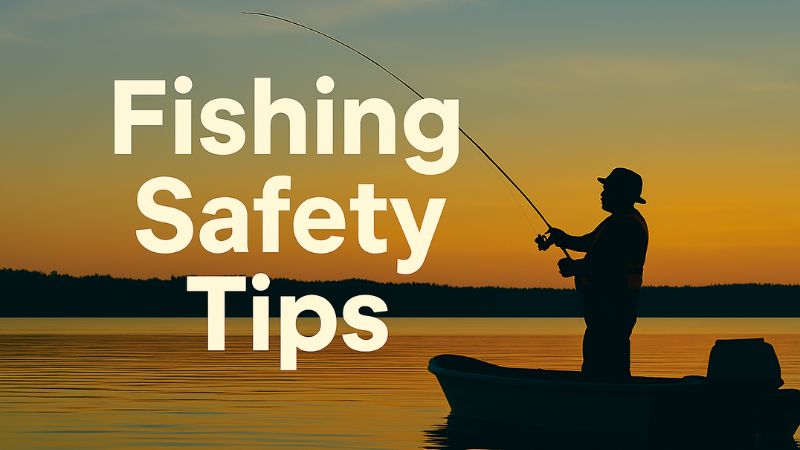Fishing Safety Tips – The Complete Guide to Staying Safe On and Off the Water
Fishing is one of those activities that can be peaceful and thrilling at the same time. Whether you’re standing by the shore, wading into a calm river, or heading out for a long boat fishing trip, a good day on the water should end with stories about the catch — not accidents. That’s why understanding fishing safety is just as important as knowing where the fish are biting.
In this guide, we’ll cover everything from gear safety to emergency preparedness, making sure you have the know-how to protect yourself, others, and the environment.
Essential Fishing Safety Principles
Pre‑Trip Planning & Weather Checks
Before you grab your tackle box, check the weather forecast. Sudden storms, high winds, or extreme heat can turn a pleasant trip into a dangerous one.
- Use reliable weather apps.
- Avoid fishing if lightning is in the forecast.
- Keep track of tide times if you’re fishing in coastal areas.
Personal Flotation Devices (PFDs)
Wearing a life jacket isn’t just for kids or deep-sea trips. Even strong swimmers can get caught in unexpected situations like strong currents or sudden falls overboard. Choose a PFD that:
- Fits snugly but allows movement.
- It is approved by your local safety authority.
- Matches the type of fishing you’re doing (kayak, boat, shore).
Buddy System & Communication Plans
Fishing alone can be peaceful, but it increases risk. Always let someone know:
- Where you’ll be fishing.
- Your expected return time.
- How can they contact you if needed?
Boat Fishing Safety
Fishing from a boat increases risk, so preparation is essential.
Boarding and Disembarking Procedures
- Keep weight evenly distributed to avoid tipping.
- Step in and out of the boat slowly, holding onto a stable point.
Life Jacket Fit & Types
- Type I: Offshore life jackets, excellent for open water.
- Type II: Near-shore buoyant vests, comfortable for calm waters.
- Type III: Flotation aids, popular among anglers for flexibility.
Boat Weight Limits & Load Distribution
Overloading a boat is a primary cause of capsizing. Check your boat’s capacity plate and adhere to its limit.
Navigation and Local Regulations
Be aware of:
- No‑wake zones.
- Fishing license requirements.
- Restricted fishing areas to protect habitats.
Shore & Wading Safety
Fishing on land or in shallow water might seem safer, but risks still exist.
Choosing Stable Footing and Recognizing Hazards
Watch for slippery rocks, loose sand, or uneven surfaces that could cause falls.
Wader Safety — Avoiding Entrapment and Cold Shock
If your waders fill with water, they can weigh you down. To stay safe:
- Wear a wading belt.
- Don’t wade deeper than your waist in fast currents.
Casting Safety on Crowded Shores
Check behind you before casting to avoid hooking someone.
Gear & Equipment Safety
Proper Handling of Hooks and Lures
Hooks are sharp and can easily injure skin or eyes. Always:
- Handle hooks carefully.
- Keep your hooks covered whenever you’re not using them.
Knife & Fillet Tool Safety
- Use a sharp knife (dull blades slip more easily).
- Always cut away from yourself.
Secure Storage of Sharp or Hazardous Gear
Store all sharp items in tackle boxes with latches, especially when kids are around.
Wildlife & Environmental Hazards
Avoiding Aggressive Wildlife
In some areas, anglers share waters with potentially dangerous animals such as crocodiles, snakes, or aggressive birds. Maintain a safe distance and respect their space.
Lightning and Severe Weather Protocols
If you hear thunder, head to shelter immediately — water is a natural conductor.
Handling Fish Safely to Avoid Injury
Some species have sharp spines or teeth. Use gloves or fish grips for better control.
Fishing Safety for Kids
Age‑Appropriate Gear
Choose rods and reels that are light and easy for kids to handle.
Supervision Guidelines
Never let children fish without adult supervision, especially near water.
Teaching Basic Safety Rules Early
Explain the dangers of hooks, the importance of life jackets, and how to handle fish. For parents just starting out, this resource on fishing for beginners is a great place to learn the fundamentals alongside your child.
Emergency Preparedness
First Aid Essentials for Fishing Trips
Keep a fishing first aid kit with:
- Bandages and antiseptics.
- Tweezers for removing hooks.
- Pain relief medication.
Responding to Common Injuries
- Cuts: Clean and bandage.
- Hook punctures: Remove carefully or seek medical help.
- Sprains: Use ice and rest.
Hypothermia and Heat Stroke Awareness
- Hypothermia: Wear layers and stay dry.
- Heat stroke: Stay hydrated and wear a hat.
Fishing Safety Quick Reference Table
| Storm approaching | Stop fishing and find shelter |
| Using knives | Cut away from yourself |
| Wading in rivers | Use a belt to prevent flooding of waders |
| Fishing with kids | Keep gear stored when not in use |
| Boat overload risk | Follow the capacity plate |
Conclusion
Fishing should be relaxing and fun, but safety has to come first. By wearing life jackets, staying aware of the weather, handling gear properly, and having a solid emergency plan, you can turn every trip into a safe and memorable outing. Preparation may feel like an extra step, but it’s the step that keeps everyone coming home with good stories — and all fingers intact.
FAQs
1. What are the most important fishing safety tips for beginners?
Always wear a PFD, check the weather, handle hooks with care, and avoid fishing alone.
2. What should be in a fishing first aid kit?
Bandages, antiseptics, tweezers, gloves, and pain relief medication.
3. How can I keep my kids safe while fishing?
Supervise closely, give them age‑appropriate gear, and teach water safety basics.
4. Are there specific safety tips for boat fishing?
Yes — wear a life jacket, distribute weight evenly, follow navigation rules, and avoid overloading.
5. How can I protect myself from aggressive wildlife while fishing?
Stay alert, maintain distance, and avoid disturbing their habitat.
6. Is lightning a serious risk for anglers?
Yes — water conducts electricity. If you hear thunder, seek shelter immediately.
7. What are the best ways to avoid hypothermia when fishing?
Wear thermal layers, stay dry, and change out of wet clothing quickly.
8. What safety measures should I take when wading?
Use a wading belt, avoid deep or fast currents, and watch your footing.
9. How should I handle fish to avoid injury?
Use gloves or fish grips, especially for species with sharp spines or teeth.
10. Can fishing safety tips change by location?
Absolutely — coastal, freshwater, and remote fishing spots have unique risks to prepare for.

